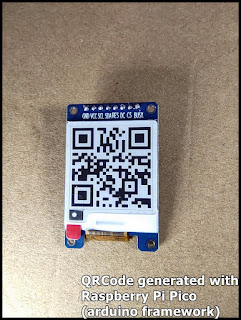Generate QRCode with Raspberry Pi Pico (arduino framework), display on 1.54" 200x200 B&W e-Paper (SSD1681)
Last post show how to display on 1.54" 200x200 e-Paper (SSD1681) with Raspberry Pi Pico using
GxEPD2 library, in Arduino framework. It's another exercise to generate QRCode with Raspberry Pi Pico, and
display on 1.54" 200x200 B&W e-Paper (SSD1681)
GxEPD2 and QRCode libraries are needed, install them in Arduino IDE's Library Manager.
Code
Pico_GxEPD2_SSD1681_qrcode.ino
/*
*Exercise run on Raspberry Pi Pico/RP2040
*display QRCode on 1.54" 200x200 e-Paper with SSD1681 SPI driver,
*using ZinggJM/GxEPD2 and qrcode lib
*
*qrcode:
*https://github.com/ricmoo/qrcode/
*/
#include <GxEPD2_BW.h>
#include <qrcode.h>
#define EPD_CS 17
#define EPD_DC 21
#define SRAM_CS -1
#define EPD_RESET 20
#define EPD_BUSY 22
GxEPD2_BW<GxEPD2_154_GDEY0154D67, GxEPD2_154_GDEY0154D67::HEIGHT> display(
GxEPD2_154_GDEY0154D67(EPD_CS, EPD_DC, EPD_RESET, EPD_BUSY));
const int DISP_WIDTH = display.width();
const int DISP_HEIGHT = display.height();
const int DISP_HALF_W = (int)DISP_WIDTH/2;
const int DISP_HALF_H = (int)DISP_HEIGHT/2;
void setup()
{
delay(500);
Serial.begin(115200);
display.init();
display.setRotation(0);
drawScreen();
drawQRCode_FullWindows();
delay(1000);
display.powerOff();
}
void drawQRCode_FullWindows()
{
// Create the QR code
QRCode qrcode;
const char *data = "https://www.youtube.com/@coXXect";
//const char *data = "http://coxxect.blogspot.com/";
const uint8_t ecc = 0; //lowest level of error correction
const uint8_t version = 2;
uint8_t qrcodeData[qrcode_getBufferSize(version)];
qrcode_initText(&qrcode,
qrcodeData,
version,
ecc,
data);
Serial.println(data);
Serial.print("qrcode.version: ");
Serial.println(qrcode.version);
Serial.print("qrcode.ecc: ");
Serial.println(qrcode.ecc);
Serial.print("qrcode.size: ");
Serial.println(qrcode.size);
Serial.print("qrcode.mode: ");
Serial.println(qrcode.mode);
Serial.print("qrcode.mask: ");
Serial.println(qrcode.mask);
Serial.println();
display.setFullWindow();
const int xy_scale = 8;
const int x_offset = (display.width() - xy_scale*qrcode.size)/2;
const int y_offset = (display.height() - xy_scale*qrcode.size)/2;
display.firstPage();
do
{
for (uint8_t y = 0; y < qrcode.size; y++) {
for (uint8_t x = 0; x < qrcode.size; x++) {
bool mod = qrcode_getModule(&qrcode, x, y);
if(mod){
int px = x_offset + (x * xy_scale);
int py = y_offset + (y * xy_scale);
display.fillRect(px, py, xy_scale, xy_scale, GxEPD_BLACK);
}
}
}
}
while (display.nextPage());
}
void drawScreen()
{
display.setFullWindow();
display.firstPage();
do
{
display.fillScreen(GxEPD_BLACK);
}
while (display.nextPage());
delay(2000);
display.setPartialWindow(0, 0, DISP_WIDTH, DISP_HEIGHT);
display.firstPage();
do
{
display.fillScreen(GxEPD_WHITE);
display.drawRect(0, 0, DISP_WIDTH, DISP_HEIGHT, GxEPD_BLACK);
}
while (display.nextPage());
delay(2000);
}
void loop() {
};


Comments
Post a Comment